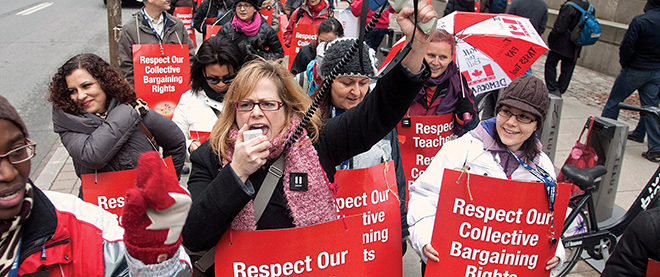Education vs. health care
The tough choices that aren’t being made
Teachers from the Elementary Teachers Federation of Ontario picket outside the provincial Ministry of Education in Toronto December 18, 2012. The picketing is part of rotating walkouts staged by the Teachers Federation to protest government action to limit union rights. REUTERS/Fred Thornhill (CANADA – Tags: BUSINESS EMPLOYMENT EDUCATION CIVIL UNREST POLITICS)
Share
 This is as good as it gets, demographically speaking. Right now, Canada is in a demographic sweet spot. Our dependency ratio is currently at an all-time low of 59 dependents (those under 19 and over 65 years old) per 100 working-age adults, who pay the bills. Our share of non-workers to workers will never be so favourable again.
This is as good as it gets, demographically speaking. Right now, Canada is in a demographic sweet spot. Our dependency ratio is currently at an all-time low of 59 dependents (those under 19 and over 65 years old) per 100 working-age adults, who pay the bills. Our share of non-workers to workers will never be so favourable again.
Two well-established trends are behind our current situation: a decline in the percentage of young Canadians due to falling birth rates; and the fact that the bulk of the baby boom generation is still working.
The problem is that this fortuitous circumstance can’t last. Public purses will soon be hit by a rising dependency ratio spurred by a flood of boomer retirees, improvements in longevity and continued sluggishness in births. In theory, governments would adapt to this changing situation by reallocating spending. In its regular update on Ottawa’s long-term fiscal outlook, for example, the parliamentary budget office recently noted that: “Population aging will put . . . upward pressure on programs whose benefits are mostly realized by Canadians in older age groups, such as health care, elderly benefits and public pension benefits.” Such a future funding crunch, however, will be “partially offset by reduced spending on programs with benefits largely focused on younger age groups, such as education.”
More retirees inevitably mean more government spending on things old people need, while fewer young people should in turn mean less government spending on things children and teenagers need. That’s the theory, at any rate. Unfortunately, this sort of budgetary self-correction is nowhere to be seen in the real world.
Last week, Statistics Canada released a lengthy summary of primary and secondary education across the country, covering the past five years. At a time when education spending should be gradually declining in step with reductions in the number of students, in fact the exact opposite is occurring.
Since the 2006-2007 school year, the total head count in Grades 1 to 12 across the country has fallen by over 200,000 students, a greater than four per cent drop. At the same time, total spending across Canada on public elementary and secondary schools has grown by $10 billion. The bulk of this increase is due to teacher compensation, which has leapt by more than $9,000 per educator over five years. Ontario teachers, to pick one example, have seen their average salaries and allowances grow from $71,000 to $80,000.
A combination of fewer students and more expensive teachers means Canadians are now spending more on each student than ever before. After correcting for inflation, per-student public spending has risen $1,300 since the 2006-2007 school year. While parents (and no doubt teachers) may think this is a good thing, it is a situation that simply cannot be maintained.
As classrooms empty out, the opposite is occurring in our nation’s long-term-care facilities and old age homes. The number of 80-year-olds, for example, is expected to double over the next decade or so.
To meet these changing circumstances, we will obviously need more health care professionals and fewer teachers. The first part of this equation is already occurring. The number of new doctors currently outpaces the population growth rate threefold. Nurses are increasing at double the rate of population growth. Canada now spends almost $6,000 per person on health care annually, or $207 billion in total, a figure that is also growing faster than the population.
Yet the other side of the ledger is clearly not dropping in step, as the StatsCan figures reveal. Despite the necessity of spending less on education, governments have been hard at work coming up with new ways to spend more: lowering the student-teacher ratio, increasing special education programs and introducing full-day kindergarten, to name a few examples. And teachers’ unions vigorously resist any efforts to rein in compensation. Ontario public school board teachers are currently in the midst of a nasty confrontation with the provincial government, and British Columbia recently went through the same unpleasant experience, with new negotiations on the same topic set to resume shortly.
Setting the proper balance between health care and education spending is not about punishing the school system or shortchanging younger Canadians. In truth, future generations of workers must become substantially more productive if Canada is to have any hope of paying for all the health care, housing support and pensions about to be demanded by the looming grey wave. But it is nonetheless necessary to reallocate spending from areas of low need to areas of high need: holding per-student spending constant and redirecting the savings that come from declining school enrolments toward programs geared to the elderly.
Fewer students must inevitably mean lower spending on education. That’s both basic math and common sense.